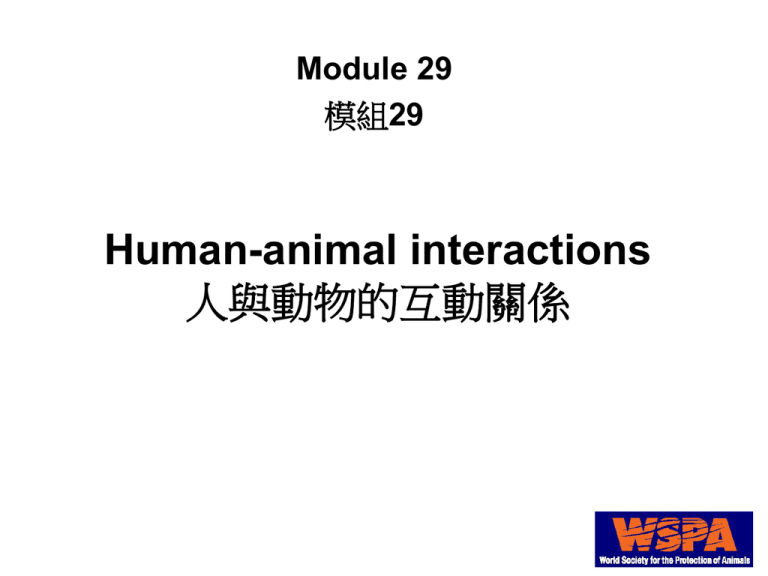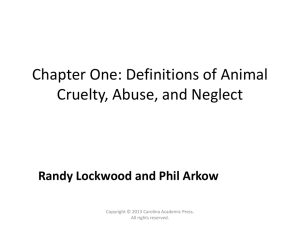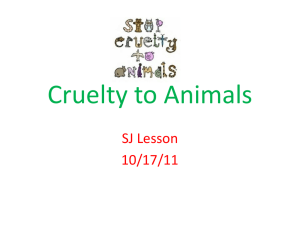29_Human Animal Bond 人與動物之連結
advertisement

Module 29 模組29 Human-animal interactions 人與動物的互動關係 This module will enable you to 此模組將使你 • Understand the variety of interactions that people have with animals明瞭人與動物互動的各種方式 • Appreciate cultural and historical variations in the popularity of companion animals領悟歷史文化演變在 伴侶動物普及化中擔任的角色 • Understand the conflicts that arise in people’s interactions with different kinds of animals了解人與各 種動物互動時會引發的衝突 • Critically assess evidence concerning links between cruelty to animals and cruelty to people用批判眼光評 價虐待動物與虐待人之間的關聯跡象 Human-animal interactions 人與動物之互動(方式) • Companion animals伴侶動物 • Utility animals役用動物 • Wild animals (not addressed in this module, see modules 21 and 23-26)野生動物 (將不會此模組討論,詳見模組21及23-26) Companion animals伴侶動物 Utility animals 役用動物 Wild animals野生動物 Why do people keep pets? 人為何要養寵物? • Companionship伴侶 • Nurturance養育 – Opportunity to give care給予照顧的機會 • Neoteny幼態成熟 • Fashion/status時尚和地位 • Collection因喜愛而收集 Courtesy Dr N. Rooney University of Bristol Companion animals are universal 伴侶動物最為普遍 Why do we interact with animals? 人類為何要和動物互動? Humans are social, emotional beings with a strong need to communicate and empathise with others人類是社會性 的、有著強烈需求與 他人溝通和產生共鳴 的情感族群 Species popularity受歡迎的物種 Domestic dogs and many cats are highly social and reciprocate interactions with humans馴養的狗和許多貓皆高度社會化並且與人 類產生良好的互動關係 Conflicting views of animals 衝突的動物觀點 • Serpell (1986): While developing affectionate relationships with companion animals is a natural and universal phenomenon…和伴侶動物發展親密的關係是自然且 普遍的現象 …humans are also motivated to use and kill animals, especially for meat, a highly valuable food source人類也有動機去利用並且宰殺動物特別是 為了肉、高價值的食物資源 Cognitive Dissonance Theory 認知不協調理論 People experience unpleasant feelings of ‘cognitive dissonance’ if they hold conflicting views or motivations. They will change their behaviour or their attitudes to avoid or overcome dissonance人若有衝突之看法或動機,會有「認知不協 調」的不愉快感覺。此時他們將改變行為或改變態度以避 開或克服此不協調之狀態。 (Festinger 1957) Dissonance 1: Ritual 不協調1: 儀式 • To win the “approval” of the hunted animal, subsistence hunters often observe rituals:為了贏得被獵殺動物的“同意”,以狩獵維生的 獵人時常會遵守以下儀式: – – – – – – – Dietary and sexual abstinence狩獵前後的禁食與禁慾 Ritual purification以儀式潔淨 Speaking respectfully of prey提及獵物的時候言語尊敬 Apologising to slain animal對獵殺之動物道歉 Ceremonial treatment of carcass以儀式處理屠體 Ritual disposal of unusable remains以儀式處理剩餘之肉 Avoidance of waste不浪費 Dissonance 2: Separation 不協調處理2: 區隔 • New Guinea Highlands新幾內亞高地 – Women raise pigs, men kill and eat them女人飼養豬, 男人屠宰豬隻作食用 • Modern urban culture:現代城鎮文化: – Raising and slaughtering meat animals done by tiny proportion of population少部分的人口從事飼養和宰 殺動物工作 • Japan日本 – Separate group (Burakumin) were butchers and leatherworkers. Still stigmatised today獨立族群 (Burakumin)擔任屠宰和製革工作。到今日仍然被歧視。 Dissonance 3: Objectification 不協調處理3: 物化 • Book of Genesis創世紀 – Man has dominion over every living thing 人為萬物的主宰 • Aristotle亞里斯多德 – Natural hierarchy, with men at pinnacle, above women & the rest of creation人是權 力的頂點,勝過其他的被造物 • Thomas Aquinas湯姆斯 – Only humans possess rational souls唯人有 理性 – All animals were created in order to serve humanity動物都是為服事人而被造 The emergence of modern pet-keeping 寵物照顧現代化 • Increasing affluence經濟富裕成長 • Urbanisation of populations城市生活人口 What effects do pets have? 寵物對人類有何影響? • Effects on human health影響人類健康 • Social effects影響社交能力 • Effects on attitudes to animals 影響對動物的態度 Attitude effects 1 態度效應1 (Serpell 1981) 80 70 60 Number 50 of people40 人數 30 20 10 0 Childhood pets 幼年時養寵物 No childhood 幼年時不養寵物 pets Owners/potential owners Non-owners Attitude effects 2 態度效應 2(Paul & Serpell 1993) 30 25 % belonging 20 to animal 15 welfare Organisations 10 %加入動保組織 5 0 0 1 2 3 4 5 6 7 8+ Number of pets owned in childhood 幼年時代擁有寵物之數目 Humane education 人道教育 ‘The expanding circle of compassion’ 關愛的漸進擴展: 從寵物到動物到人類 Pets寵物 All animals所有動物 People人類 Is cruelty to animals and to humans linked?對動物殘忍與對人殘忍是否有關? Two possible associations 二種可能的相關性 Graduation hypothesis 畢業假說 • Child who is cruel to animals虐待動物的兒童 • ‘Graduates’ to harming people in adulthood”在 成年後發展(畢業)至對人 傷害 Co-occurrence hypothesis 同步發生說 • Animal abuse co-occurs with child abuse/wife battering?虐待動物和虐待 兒童/虐妻同時發生? • Animal neglect co-occurs with child/self neglect?忽 視動物和遺棄兒童/自己同 時發生? Research methods研究方法 • Case studies of infamous serial killers研究不著名的連續殺人 案例 • Retrospective interviews with aggressive and nonaggressive criminals 回顧性訪問具有攻擊性與不具攻擊性罪 犯 • Retrospective interviews with students 回顧性訪問學生 • Problems: Self reports may be misremembered or fabricated 問題: 自我報告可能會記錯或捏造 Evidence for ‘Graduation’ hypothesis“畢業假說”之證據 • ‘Graduation’ from animals to humans not yet proven 由傷害動物‘畢業’ 至傷害人還未被證實 • Extreme child cruelty to animals contributes to a diagnosis of conduct disorder虐待動物的偏激兒童是 行為障礙的診斷因子 • Conduct disorder can precede adult diagnoses of severe and anti-social personality disorder (psychopathy)行為障礙可能在成年後嚴重反社會性人 格疾病(精神病態)發生之前出現 • Aggressive children harm animals and humans有攻 擊性的兒童會傷害動物和人 Evidence for Co-occurrence hypothesis“同步發生假說”之證據 • Case studies and interviews suggest a link between abuse/neglect of animals and abuse/neglect of children個案研究和訪談顯示虐待/遺棄動物和虐待/遺 棄兒童之間之相關性 • However, abuse of animals may not always spill over into abuse of humans (and vice versa)然而虐待動物 並不一定會造成虐待人類(反之亦然) • What is needed: Professional vigilance (e.g. vets), more data collection, further research應該怎麼作: (加強)專業人士之警覺性(如獸醫師)、收集更多 數據資料、進一步的研究 However…然而 • Institutionalised or socially sanctioned animal cruelty is less likely to generalise to cruelty/violence towards humans 慣性或社會認可下的傷害動物(屠宰場) 並不歸納被視為會傷害人類或使用暴力 • People who abuse animals alone are most likely to be a danger to others 會獨自傷害虐待動物的人最有可能對其他人 構成危險 Conclusions結論 • Humans have many different interactions with animals人與動物的互動關係種類繁多 • The human-animal relationship in modern society most commonly involves companion animals在現代 社會最普遍的人畜關係經常與伴侶動物有關 • Companion animals have many functions and effects 伴侶動物用途廣泛,影響深遠 • Cognitive dissonance arises from conflict between affectionate and utilitarian relationships with animals 人與動物的親密關係與利用關係互相衝突時,就會導 致認知上的不協調 Conclusions結論 • Caring for pets may lead to greater compassion for other animals and even humans關懷動物會引發更多 對其他動物甚至人類的惻隱之心 • Cruelty to animals can be associated with abuse and violence towards other humans虐待動物可以與傷害 他人和施行暴力有關 Further Reading進階閱讀 • • • • • • American Psychiatric Association 1994 Diagnostic and Statistical Manual, vol 4. Arluke AB. 1988 Sacrificial symbolism in animal experimentation: Object or pet? Anthrozoos, 11, 98-117 Arluke A, Levin J, Luke C & Ascione F. 1999 The relationship of animal abuse to violence and other forms of antisocial behaviour. Journal of Interpersonal Violence, 14,963-975 Arluke AB. 1988 Sacrificial symbolism in animal experimentation: Object or pet? Anthrozoos, 11, 98-117 Basso CB. 1973 The Kalapalo Indians of Central Brazil. New York: Holt, Rinehart and Winston Duncan A & Miller C. 2002: The impact of an abusive family context on childhood animal cruelty and adult violence. Aggression and Violent Behaviour, 7, 365-383. • Festinger LA. 1957 A Theory of Cognitive Dissonance. Stanford, C.A.: Stanford University Press. Further Reading進階閱讀 • • • • Fisher MP. 1983 Of pigs and dogs: Pets as produce in three societies. In Katcher AH & Beck AM. (Eds.) New Perspectives on Our Lives with Companion Animals. Philadelphia: University of Pennsylvania Press. (pp. 132-137) Kellert S & Felthous A. 1985 Childhood cruelty toward animals among criminals and non-criminals. Human Relations, 18, 113-1129 Paul ES. 2000 Empathy with animals and with humans: Are they linked? Anthrozoos, 14, 194-202 Paul ES & Serpell JA. 1993 Childhood pet keeping and humane attitudes in young adulthood. Animal Welfare, 2, 321-337 • Podberscek AL, Paul ES & Serpell JA. 2000 Companion Animals and Us: Exploring the Relationships Between Pets and People. Cambridge, UK: Cambridge University Press • Serpell JA. 1981 Childhood pets and their influence on adults’ attitudes. Psychological Reports, 49, 651-654. Further Reading進階閱讀 • Serpell J & Paul E. 1994 Pets and the development of positive attitudes to animals. In Manning A & Serpell J. (Eds.): Animals and Human Society. London: Routledge. • Serpell JA. 1986 In the Company of Animals Oxford: Blackwell • Serpell J. (Ed) 1995 The Domestic Dog: its evolution, behaviour and interactions with people. Cambridge University Press • Thomas K. 1983 Man and the Natural World: Changing attitudes in England, 1500-1800. London: Allen Lane. • Turner DC & Bateson P. (Eds) 2000 The Domestic Cat. The biology of its behaviour (2nd edition). Cambridge University Press Resources資源 • National Society for the Prevention of Cruelty to Children. Understanding the links: child abuse, animal abuse and domestic violence. Information for professionals. http://www.nspcc.org.uk/Inform/Research/Findings/UnderstandingTh eLinks_asp_ifega26207.htmlformation for professionals • People for the Ethical Treatment of Animals. Information for Prosecutors, Police Officers, Magistrates and Judges. PETA Research and Education Foundation, London, UK










